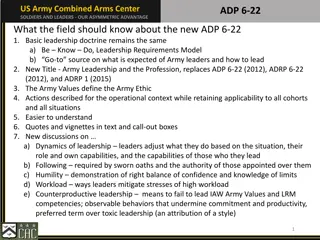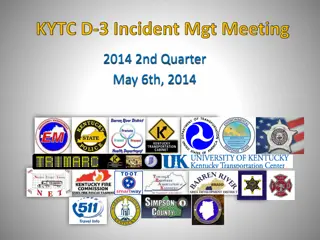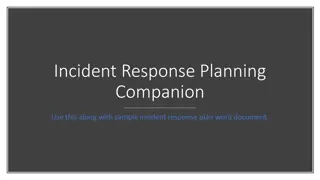Effective Team Formation in Public Health Incident Leadership
Explore the key aspects of team formation in public health incidents such as setting the tone, orienting the team, and establishing expectations. Learn how high-reliability teams operate and the importance of leadership in ensuring team reliability and efficiency. Understand the roles within an Incident Command System (ICS) team and how to develop a reliable and effective team for optimal response in crisis situations.
Download Presentation

Please find below an Image/Link to download the presentation.
The content on the website is provided AS IS for your information and personal use only. It may not be sold, licensed, or shared on other websites without obtaining consent from the author.If you encounter any issues during the download, it is possible that the publisher has removed the file from their server.
You are allowed to download the files provided on this website for personal or commercial use, subject to the condition that they are used lawfully. All files are the property of their respective owners.
The content on the website is provided AS IS for your information and personal use only. It may not be sold, licensed, or shared on other websites without obtaining consent from the author.
E N D
Presentation Transcript
Public Health Incident Leadership MODULE 4: TEAM FORMATION August 2015
Objectives Understand the importance of developing a reliable team Identify effective procedures in setting the tone and orienting Incident Management Team members Describe general expectations that an Incident Commander may have for his/her Incident Management Team
Team Formation Reliable teams Setting the tone Orienting the team Establishing expectations
Team Composition Incident Commander Public Info Officer Safety Officer Liaison Officer Operations Chief Planning Chief Documentation Logistics Chief Finance/Admin Scribes 3 3 3 3 3 3 3 3 3 3 Total team members 30 How many potential ICS teams are possible with these activated roles? Team of 10 people
High Reliability Teams Can always be counted on to perform
High Reliability Teams Form and reform for each response Engage in regular feedback Develop a sense of trust and confidence Create mechanisms to cooperate and coordinate Manage and optimize performance outcomes
High Reliability Teams Hold a Shared Mental Model Have clear roles and responsibilities Optimize resources Have clear, valued, and shared vision and STRONG LEADERSHIP
Setting the Tone Reasons the Leader needs to set the tone: Major mind shift Team members may not know each other Confidence in the Incident Commander and each other Same page
Setting the Tone Incident Commander Video Clip 1 Incident Commander Video Clip 1
Setting the Tone Describe your reaction to this Incident Commander. Will this Incident Commander be able to form an effective, reliable team?
Setting the Tone II Incident Commander Video Clip 2 Incident Commander Video Clip 2
Setting the Tone II Compare the two videos. What differences did you see? Which of these Incident Commanders has the better chance of creating an effective response?
Incident Commander Orientation Checklist A sample of items from the Checklist: Introductions Housekeeping details (restrooms, copiers, etc.) Job Actions Sheets Location of ICS forms Expectations during Briefings
Expectations of Incident Management Team As an Incident Commander, what are your expectations of the response team? What are the characteristics or traits of a model Incident Management Team member?
Expectations of Incident Management Team 1. Attend meetings 2. Resolve disputes 3. Share information 4. Maintain planning process 5. Promote the Incident Command System
Expectations of Incident Management Team 6. Take decisive action 7. Keep tactical operations in the forefront 8. Take care of themselves 9. Maintain a positive attitude 10.Take care of each other
Self-Care Incident Commander Team Span of Control Monitoring Task Completion Tools Breaks Eating Sleep Disconnecting Behavioral health resources
Framework for Public Health Incident Leadership Skills Behaviors Do Performance Skills Leadership Knowledge Cognitions Think Situation Monitoring Communication Attitudes Affect Feel Mutual Support Attitudes Knowledge























